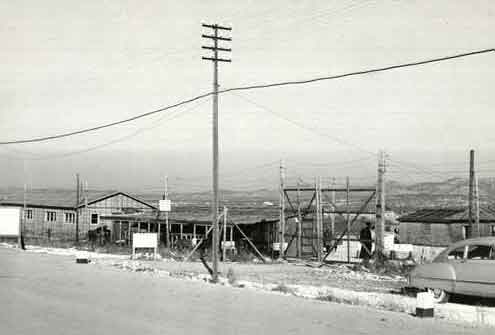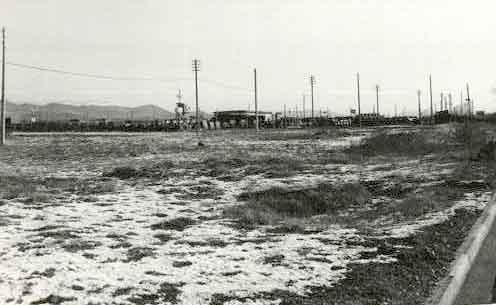Brief history of Trieste From Wikipedia, the free encyclopedia. Trieste (Latin: Tergeste, Italian: Trieste, German and Friulian: Triest, Slovenian and Croatian: Trst) is a city and port in northeastern Italy, capital of the autonome region Friuli-Venezia Giulia and Trieste province, with a population of 211,184 (2001). It is located 600 kilometers south-southwest of Vienna at the head of the Gulf of Trieste in the Adriatic Sea. Quay along the Adriatic
The sights in Trieste include Miramare, a romantic castle built in the 19th century for Austrian Archduke Maximilian and his wife. On the coastal road to Trieste is the Abdus Salam International Centre for Theoretical Physics, operating under the aegis of UNESCO and IAEA.
Through a long period of time, Trieste was seen as being peripheral to the centers of Italian commerce and culture, and lost influenc--however lately it has been gaining influence as Italy's window to the East.
The local Venetian dialect of Trieste is called Triestin in Italian and Triestino (pronounced tri.e.stin) in the local language itself. Italian and the local venetian dialect are spoken in the city center while Slovenian is partially spoken in many of the immediate suburbs. Italian-speaking and Slovenian-speaking locals are considered autochthonous into the border region of Trieste, eastern Friuli and Istria. A fair number of German-speakers are native to the city too.
On May 1, 1945 the Yugoslav army entered Trieste (see Foibe) one day before before the New Zealand army, in a race to decide who would control the city. The German Army surrendered to New Zealand army on May 2. International pressure made the Yugoslavs leave the city on June 12.
In 1947 Trieste became an independent state as the Free Territory of Trieste. This state was de facto dissolved in 1954 as un-governable and in 1977 in the Treaty of Osimo officially subdivided between the two countries: the city of Trieste went to Italy, while the southern part of the territory went to Yugoslavia.
Camps:Gesuiti
Opicina
San Sabba
San Sabba Annex
City archives: http://www.retecivica.trieste.it
Records of the Allied Military Government, British-United States Zone Free Territory of Trieste
Under the terms of the Peace Treaty of 1947 with Italy, the territory under the administration of the Allied Military Government for Venezia Giulia was divided between Italy and Yugoslavia except for a specified area around Trieste. The territorial remnant was established on September 15, 1947, as the Free Territory of Trieste and was occupied by joint British-American forces as the Allied Military Government, British-United States Zone, Free Territory of Trieste. Major General Terence S. Airey was the first Zone Commander and Military Governor, followed by Major General Sir T.J.W. Winterton. In October 1954 the Allied Military Government was abolished and the Territory turned over to the control of the Italian Government.
For pertinent records please consult the finding aids and reference staff in the consultation area in Room 2400. United States National Archives (NARA)
Apr 7, 2015
I'm going through a collection of photos my father took while in Trieste Italy in 1953 (He was in the American Army, CID.)
Here are two photos that have been identified as the Opicina DP camp.
Charlene Percival cvp@fidmail.com More photos on http://www.facebook.com
Sun, Jul 19, 2020
For some years now I have been looking at your website and it has been really helpful to me. You have done a massive job.
I am writing to you as I have just completed a new website which has a lot of photos, reports and information on 5 Displaced Persons Camps, collected by my mother, Clare McMurray/Wositzky.
In 1948-51, my mother worked in several camps in Austria and Trieste and brought with her to Australia photographs, monthly reports, refugee art and handcraft. I decided that it would be wonderful if this material was accessible to the people or their families who were in the camps at the time - hence I have just put it all on a website.
The camps mum worked in Austria were Eisenerz, Kapfenburg, Reid Rehabilitation Centre, and the YMCA Simmer Camp program in Waiern and Ebanesse. She also worked in Trieste - in San Sabba, Opincina and Gesuiti. The website has a lot of material from all of these camps.
The link is www.displacedpersoncampcollection.org
Thanking you, Katherine Wositzky katherine.w@optusnet.com.au
Hi!
I found this
site and I must say it´s been very helpful for me. My origin
family lived at San Sabba Annex in Trieste, Italy between 1950-1952.
I was a child then and became very sick in TBC. In the end of summer
1952 my mother and I was transported to Sweden. Unfortunately my
mother died shortly after that, very young, and I was never able
to hear the details of the history.
I´ve found an old document addressed to my mother and with informations about permission to go to Sweden. It was addressed to San Sabba Annex DP Camp, Trieste. I can´t find any information about the Annex but a lot about the Riseria San Sabba.
Do you know if the Annex was a separate area or the same as the Riseria? If it was separate, does it still exist?
Today I´m 63 years old and trying to open the closed doors in my life. I am a minister in the Swedish Lutheran Church but newly retired. Even the smallest information would be very helpful to me.
Best wishes, Andronik Kedidjan niclas.kedidjan@telia.com
1/21/06 Hi, Olga
I found your web site most interesting. In fact, it brought back memories. My late mother and I arrived
in what was then Zone A of the Free Territory of Trieste, held by Allied
Military Government (A.M.G.), with hundreds of other refugees who came streaming
across the borders from Yugoslavia in 1950.
The A.M.G. set up emergency internment camps to house about four thousand of this tragic army, who were fleeing at the rate of 800 a day. I recall the heavy rains, chilled by the Borah and the hundreds of refugees running for cover to shut themselves in tents, huddle together and try to forget the cold.
In the next three years, we were moved by the A.M.G. from that early impromptu tent camp, near the Yugoslav frontier, to Trieste's "San Sabba, then "Opicina" and finally to the newly-constructed "San Sabba Annex," where men, women and children were still crammed to the point of suffocation. Upon our arrival, "San Sabba" was already crowded with almost 2,400 people of many nationalities, most of whom were White Russians who had fled to Serbia after the 1917 Revolution. The rest were Serbians, Bulgarians, Romanians and Serbians from Romania who had fled into Yugoslavia during World War II and after when the Eastern European countries came under Communist control, they left for Trieste. We could hardly believe our eyes to find that these refugees were now packed like sardines into this derelict burned-out rice mill that was a Nazi death camp five years earlier. They ranged from a baby, weeks old, to a 90-year-old former Serbian general.
Months later, we were moved to another camp, some seven kilometers away called "Opicina," high up on a high overlooking Trieste. In both "San Sabba" and "Opicina" we found the same overcrowded conditions, however "Opicina" had slightly better sanitary conditions, and attempts were being made to keep most of the serious T.B. cases there. A TB epidemic had broken out at about that time, and representatives from the World Health Organization (WHO) came to monitor the situation, and report on its containment. "Opicina" soon began to resemble a reception center with the influx of new refugees, the camp being scarcely a mile from the Communist Yugoslav border. Another anomaly began manifesting itself, with some refugees disappearing.
If "San Sabba" and "Opicina" were bad enough, a third camp, located in downtown Trieste, called "Gesuiti" was -- in the words of my Serbian friend Drago Jevtic -- the worst of the lot. "Gesuiti" or "the Black Hole of Calcutta" was, according to Jevtic,"a grim-looking stone structure, dating back to the Hapsburg period, that the Italian Government normally housed 400 prisoners. When I arrived in 1950, the American Military Government had more than 1,000 single boys and men crowded and crammed from the dungeons to the rafters. There were no harsher accomodations as I recall than any prison could ever offer. I was shocked to find that this was the welcome for those who, like myself, had given up everything in Serbia to enjoy the freedom of the West. Freedom, you may say, in a Jesuit prison appropriated and, almost without facilities, turned into an internment camp.
Jevtic went on to spend four years in Trieste before emigrating to Quebec (Canada) via France.
Food was at a premium there and when it was served, it was awful. I remember, one day a group of American GIs (TRUST) took me along with two of my friends to their mess hall to feed us. We must have looked pretty emaciated. It was the best meal we'd had in years. On another occasion, a group of British soldiers (BETFOR) decided to take us to their mess hall but their food, a little better than what we were getting at Gesuiti, couldn't compare to the quality and quantity we experienced at the American mess hall, needless to say.
There were suspicions about a few refugees in "San Sabba," "Opicina," and "Gesuiti" who were continually disappearing, going back across the border at night into Croatia or Slovenia ostensibly to revisit their families, but always raising the possibility that they were on a spying mission.
Finding gainful employment was an impossibility for all Yugoslav nationals. No one dared to upset Trieste's already overcrowded labour market.
These seemed idiotic and insuperable difficulties that we encountered, but in the thick of this maelstrom of chaos we found individuals with whom we could share our common fate as we waited to re-enter Canada.
Olga, I would appreciate very much if you would include "San Sabba DP camp" as one of your many transit camps of post-World War II Europe. I would be more than happy to share my family's experience as refugees of the early Cold War period, if you're interested.
Here's a website you should like: It has exterior and interior shots of San Sabba.
http://www.windcloak.it
The best gallery of still
city (Trieste) snapshots that I have found in my research is the following
Old Soldier's Home (TRUST & BETFOR):
http://www.beyondthebluehorizon.com
The first photograph (Panorama 1) is of Canal Grande where two churches stand side-by-side, one Italian Roman Catholic (Chiesa di S. Antonio) and the other Serbian Orthodox (Chiesa di S. Spiridone), the second is the famed Miramar, the third is Piazza dell'Unita, and the fourth is Trieste at night.
There is another panaramic virtual site, just as interesting:
http://www.tergeste.net/PzSAntonioJ.htm
Regards and best wishes for the New Year,
Michael Petrovich
email: MichaelPetrovich@hotmail.com
2/1/06 Hi Olga:
It was so good to discover your web site on San Sabba. We arrived at San
Sabba (my grandmother, mother, sister and myself) from Banatsko Novo Selo in 1950. From what I remember we were placed in the annex, where we lived for 4 years. Then we were moved to San Sabba. Makes me feel good to share this experience. Michael's email to you said it all. I had many friends as a girl in San Sabba, but lost touch with them. Thanks for a wonderful web site and if you know where I could get more info and pictures please let me know.
Italian search engine: http://search.virgilio.it/

